What’s the Buzz
The Bee Healthy Blog
How to Do Lunges: Tips for Proper Form
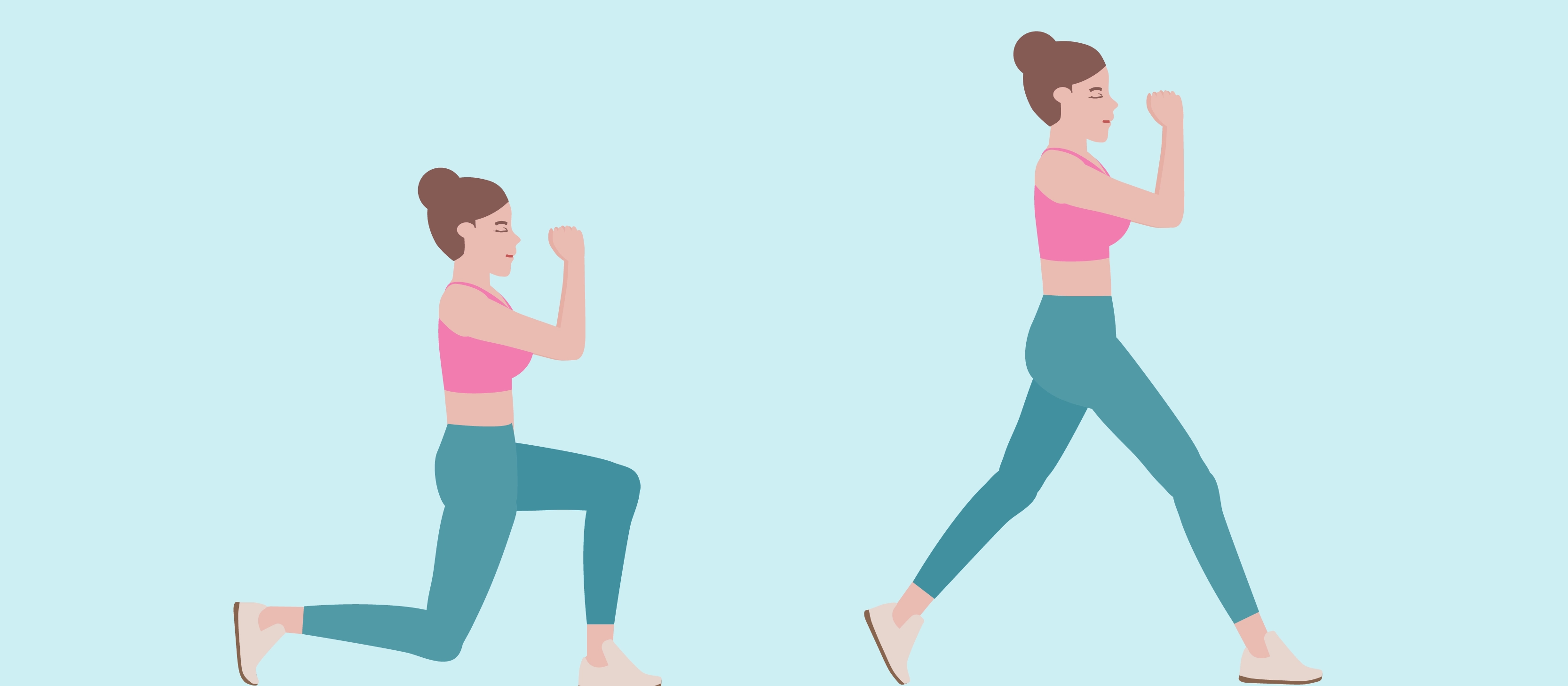
-
Lunges are an essential exercise that targets major leg muscles like the quadriceps, hamstrings, and glutes. They improve lower body strength, balance, flexibility, and core stability, making them crucial for various fitness goals and sports.
-
Proper lunge technique is critical to avoid injury. Key mistakes to avoid include taking too big a step, leaning forward, or letting your knee pass your toes (poor knee alignment). Maintaining a straight torso and balanced weight is vital for effectiveness.
-
Lunges offer various variations like forward, reverse, and jumping lunges, each targeting different muscle groups. Adding weights, such as dumbbells or a barbell, increases intensity, helping to build muscle and enhance fat-burning capabilities.
Lunges are one of those exercises that really pack a punch for your lower body. They’re perfect for strengthening your legs, improving your balance, and boosting flexibility. Whether you're looking to tone up or add some variety to your routine, lunges have got you covered. Let’s break down how to do them right and mix things up with some fun variations.
What Are Lunges?
Lunges are a lower body exercise done in a standing position. They involve large muscles such as the glutes, quadriceps, hamstrings, and calves. They are unilateral exercises and target one side of the body at a time.
Lunges are a powerful exercise that can help shape and strengthen the lower body muscles. They are excellent conditioning exercises for sports in which lunging movements are common, for example, tennis, soccer, and basketball. They can also be used as part of a circuit training or strength training routine.
How To Do Lunges Correctly
Proper Form and Technique
The correct form and technique for a lunge workout is to keep your torso straight and your core muscles engaged as you bend your knees and lower your body toward the floor.
Step-By-Step Instructions
Here is a step-by-step guide on performing a standard lunge:
-
Starting position: Stand in an upright position in a split stance with your right foot roughly 2 to 3 feet in front of your left foot.
-
Form: Keep your torso straight, shoulders back and down, and core muscles engaged.
-
Lunge: Rest your hands on your hips and bend your knees. Inhaler as you lower your body until your rear knee is a few inches from the floor. At the end of the movement, your front thigh should be parallel to the floor, your front knee should be at a 90-degree angle above your toes, your back knee should point towards the floor, and your weight should be evenly distributed between both legs.
-
Finish: Exhale as you return to the starting position, ensuring your body weight is on your front heel.
Common Mistakes To Avoid
-
Taking too big or too small a step forward.
-
Leaning forward or backward with your torso.
-
Allowing your front knee to cave in or out.
-
Letting your front knee go past your toes.
-
Letting your back knee go behind your hip.
-
Holding your breath during the lunge exercise.
Lunge Variations
Forward Lunges
A forward lunge is a dynamic variation of the standard lunge that involves stepping forward during the exercise.
-
Start by standing upright with your feet slightly apart.
-
Take a large step forward as you lower your body until your front leg (thigh) is parallel to the floor.
A more intense variation of this is a “forward lunge with reach.” It’s done in the forward lunge position but with your arms extended in front of you instead of resting on your hips. Forward lunges with reach help to build core strength and improve balance.
Walking Lunges
Walking lunges are a variation of the forward lunge.
-
Stand with your feet hip-width apart.
-
Hold a dumbbell in each hand.
-
Make sure your torso is straight and your core is engaged.
-
Take a big step forward with one leg.
-
Lower your body towards the floor until both knees are bent at 90 degrees and your front leg (thigh) is parallel to the floor.
-
Bring your back foot forward and step straight into another forward step.
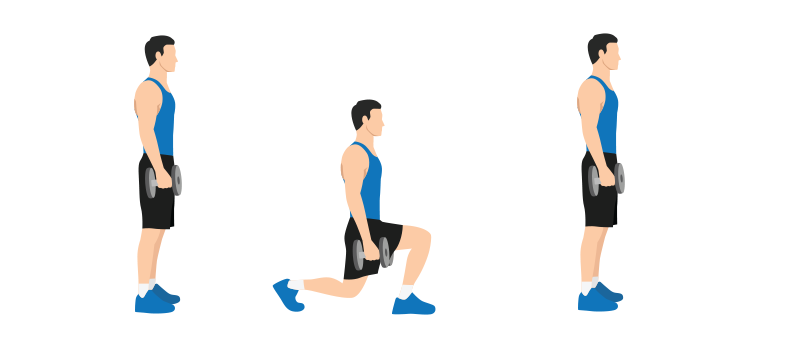
Jumping Lunges
Jumping lunges are a high-intensity variation of forward lunges. They involve jumping up and switching the lunging leg mid-air. A jumping lunge works on the glutes, quadriceps, hamstrings, and leg muscles and also helps to improve balance and coordination.
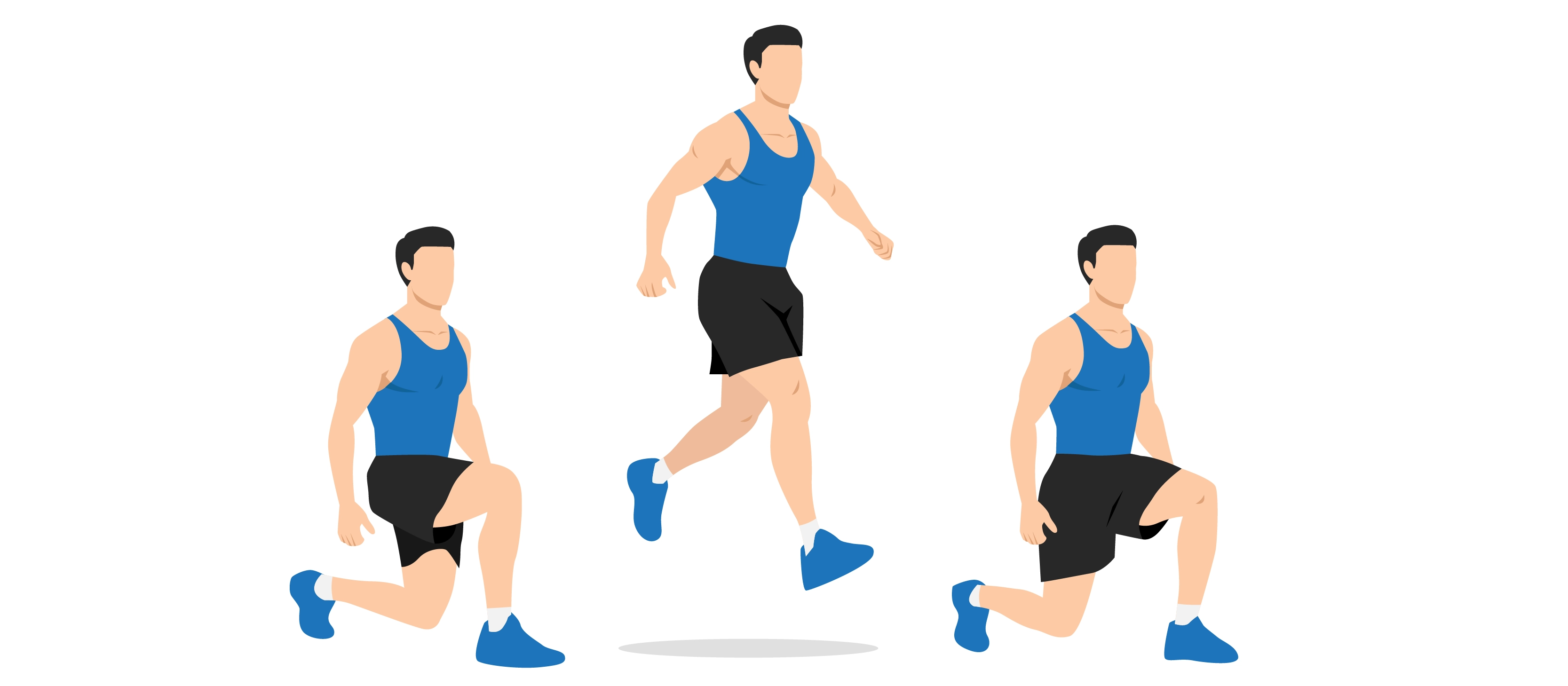
Reverse Lunges
-
Start with your feet hip-width apart and your core muscles engaged.
-
With your hands on your hips, take a wide step back (about 2 to 3 feet) with your left leg.
-
Lower your body into the lunge position until your front knee is at a 90-degree angle. Make sure your right knee doesn’t go past your toes.
-
Push back up to the standing position.
Curtsy Lunges
Curtsy lunges, also called curtsy squats, are a variation of the reverse lunge. To perform a curtsy lunge, cross your back leg behind your front foot as you bend both knees. By crossing one foot behind the leg, a curtsy lunge places more emphasis on the smaller muscles in the buttocks (gluteus medius and gluteus minimus) as well as the inner thighs and also improves balance.
Lateral Lunges
Also called side lunges, these exercises target your inner thighs, hips, and glutes. To perform a lateral lunge:
-
Stand with your feet together.
-
Take a big step to the side with your left foot.
-
With both feet pointing forward and your weight back in your glutes, bend the right knee as you lower your body down. Your front knee should not go past your toes.
-
Straighten your right leg and step back in with your left leg to return to the starting position.
-
You can add a paper plate below the side leg to target your inner thigh muscles.
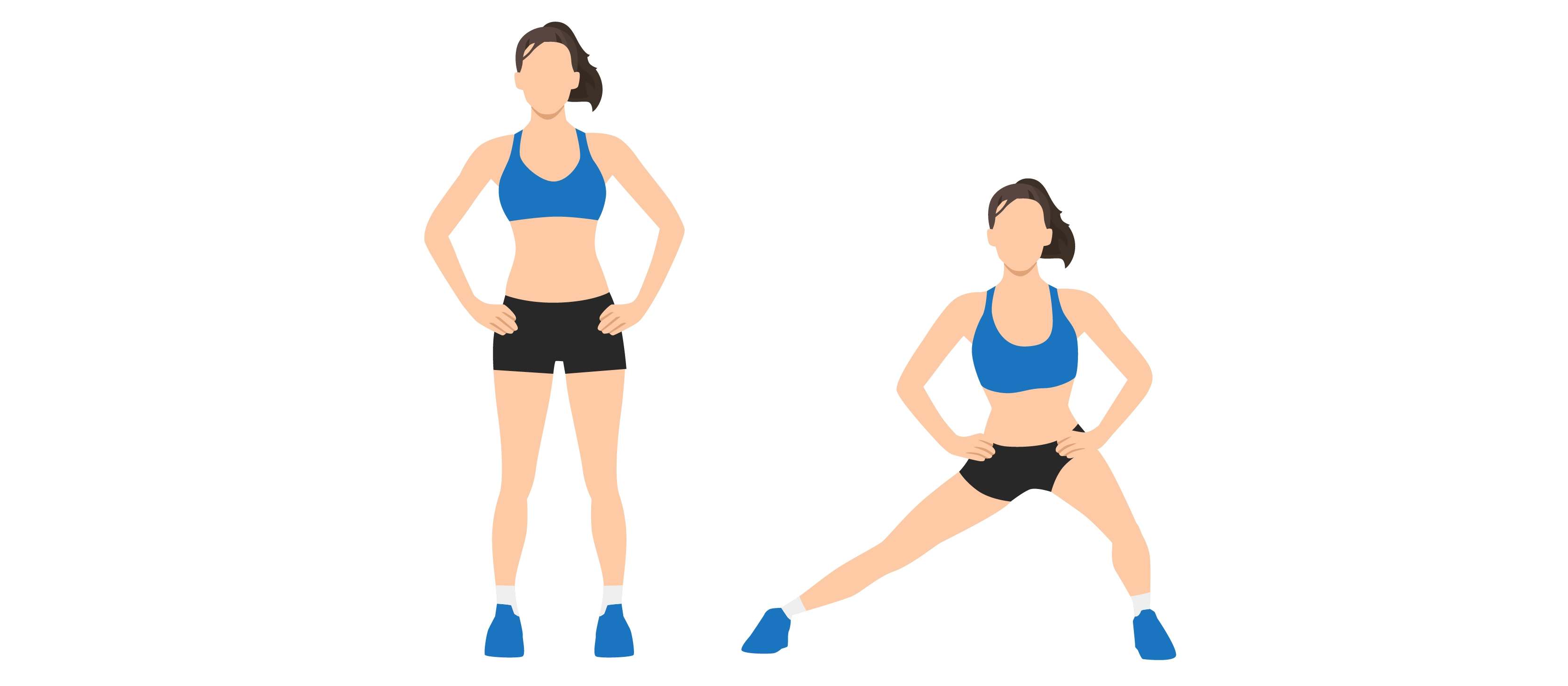
Dumbbell Lunge and Barbell Lunge
You can add intensity to your lunges by adding weights. For a dumbbell lunge, hold a weight in each hand with your arms hanging by your sides instead of resting on your hips. Then, follow the same basic steps as a standard lunge. Start with light weights and gradually work your way up to heavier weights.
For a barbell lunge, hold the barbell behind and across your shoulders while doing the lunge. This variation distributes the weight over your whole body, so you can do it with heavier weights. However, make sure you have good balance during basic lunges before attempting barbell lunges.
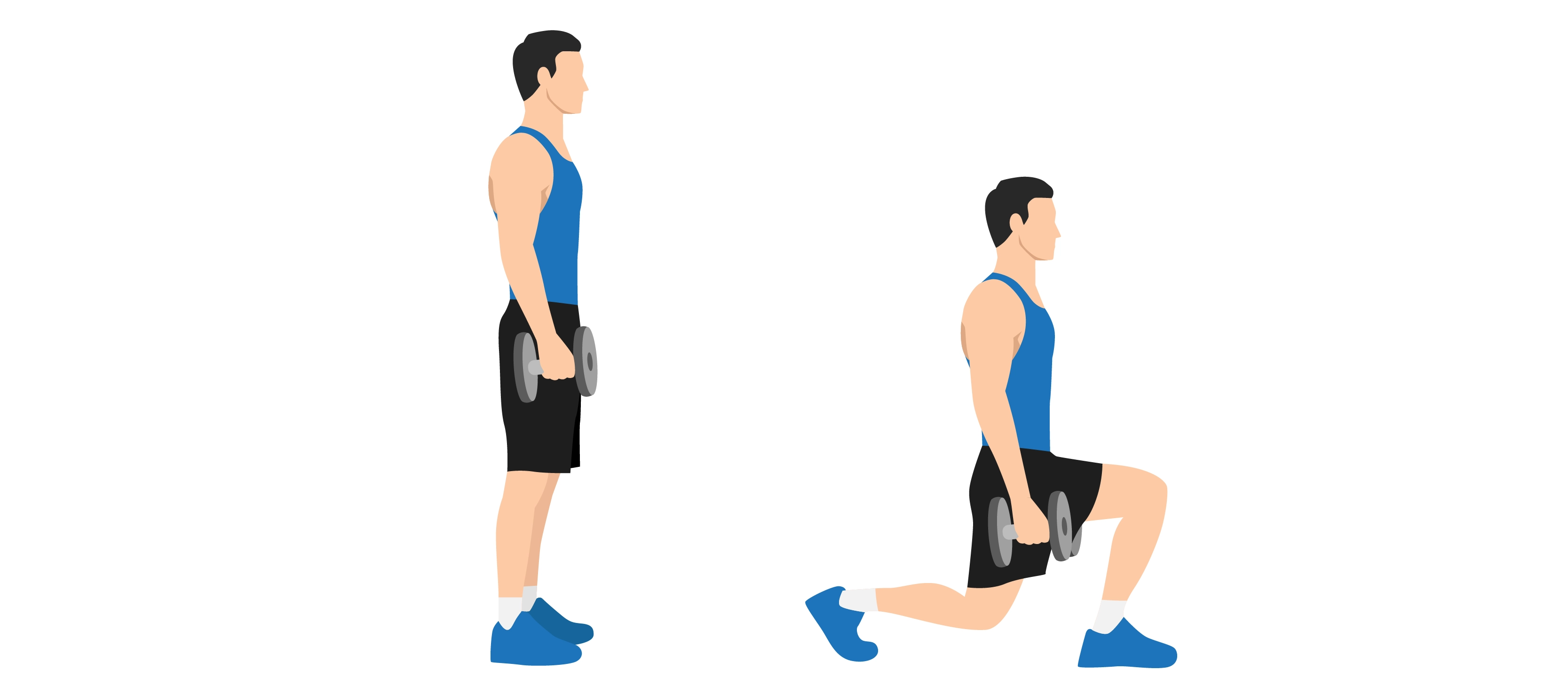
Lunges for Different Fitness Levels
Tips For Beginners
Consider learning the correct form for lunges exercises from a licensed trainer or physical therapist if you are a beginner.
Assisted Lunge: Beginners can start by doing assisted lunges. In this lunge variation, you hold a stationary object, such as a chair or wall, for balance and support. This allows you to focus on your form without worrying about losing your balance and falling. Stand with the chair or wall beside you and nearest to your rear leg. Place your hand on it for balance during the lunge.
Reverse Lunge: Reverse lunges are another great option for beginners because the movement is easier to control.
Tips For Seniors
Half Lunge: Seniors can consider doing half lunges. In this variation, you do a smaller range of motion by only lowering down half as much as a standard lunge and stopping before your front knee is at a 90-degree angle. Half lunges put less strain on the knees and are a good option for people with knee pain.
Front Foot Elevated Lunge: In this variation, you place your entire front foot flat on a step or platform. Then, slowly lower your body until your front thigh is parallel to the floor.
Advanced Lunges
Sliding Lunge: People who want to challenge their quads and core can do sliding lunges. Stand in a split stance position with one leg 2 to 3 feet in front of the other leg. Place a paper plate under the opposite foot (back foot). Slide it back as you lower your body towards the floor and pull it back as you return to standing.
Rear Leg Elevated Lunge with Weights: Place your back leg on a bench or exercise ball and hold dumbbells in your hands. Extend your arms forward as you lower yourself to the floor. This variation targets the quadriceps muscles in the back of your thigh.
Benefits of Lunges
Let’s explore the many benefits of lunges. Not only do they target key muscle groups in your legs, but they also help improve your balance, flexibility, and core strength—all while burning fat.
Improved Balance, Flexibility, and Core Strength
Lunges are a versatile exercise that engage many muscles and mimic functional movements from daily life. They target major leg muscles and improve lower body strength. Lunges are a unilateral exercise that involve one side of the body at a time. This forces the body to engage stabilizing muscles and improves balance and flexibility. Lunges also involve your abdominal muscles and improve core stability and strength.
Muscle Groups Targeted
Lunges work on large leg muscles, including:
-
Quadriceps muscles: These are large muscles on the front of the thigh that are used in walking, running, and jumping.
-
Hamstring muscles: These muscles at the back of the thigh are used for walking, climbing stairs, and doing squats.
-
Gluteal muscles: Three muscles make up the buttocks and are used for walking, running, and standing on one leg.
-
Leg muscles: The calf muscles (gastrocnemius, soleus, and plantaris) help to stabilize you during the descent and ascent in a lunge.
Find out why muscles get sore.
Lunges for Fat Burning
Lunges work on the large muscle groups in the lower body, which helps to build muscle mass and reduce body fat. They are compound exercises that work multiple muscle groups at the same time. This makes them particularly effective in burning fat.
Lunges vs Squats
Both lunges and squats are excellent lower body exercises for building muscle strength. They work on the same muscles and both can be an important part of your workout routine. However, squats are generally considered a better exercise for building muscles while lunges are better for improving balance and coordination.
Keep in mind that lunges are a unilateral exercise that works on one side of the body at a time. Squats are a bilateral exercise that works on both sides of the body at the same time. As a result, balancing is easier during squats, which allows you to add larger weights to the exercise, which can lead to faster muscle gain.
If your goal is to increase muscle bulk and strength, choose squats over lunges. If you want to improve balance and coordination along with muscle strength, choose lunges over squats.
Safety Tips For Performing Lunges
Joint Safety
To protect your knees during lunges, start by doing half lunges (going only halfway down rather than a full lunge). Also, consider doing reverse lunges. Lunging backward allows you to focus on your form. Plus, the lack of forward momentum prevents the front knee from moving too far forward, which can cause knee pain.
To protect your ankle joints during lunges, distribute your body weight evenly. Make sure your front knee is over your ankle and not past your toes. Also, make sure your back knee is under your hip and not behind it.
Hip-Width and Step Considerations
When performing lunges, keep your legs hip-width apart. This stance is important for proper form and balance. Also, ensure your back knee doesn't angle inward to avoid compromising the lunge depth.
For a proper lunge, the size of the step should be 2 to 3 feet. This allows both knees to bend to approximately 90 degrees with the front knee staying behind the toes and the back knee lowering to a few inches above the ground.
Frequently Asked Questions About Lunges
Which Is Better: Walking Lunges or Standing Lunges?
Both standing and walking lunges are great for strengthening lower body muscles. However, walking lunges engage more muscles and are more challenging to balance and stability, which makes them a superior functional exercise.
Do Walking Lunges Reduce Belly Fat?
Walking lunges may help to reduce belly fat by engaging your core muscles. However, if you want to specifically reduce belly fat, consider adding exercises such as crunches, burpees, mountain climbers, and Russian twists to your workout routine.
How Do You Know If You're Doing Lunges Correctly?
You are doing lunges correctly if:
-
Your front knee does not go past your front ankle.
-
You do not bend forward or backward while going into the lunge.
-
You do not arch your back on the way up.
How Long Should a Beginner Do Lunges?
People who are beginners to lunges exercise should do 1 to 2 sets of 10 to 12 lunges per leg to start with.
What Are The Disadvantages of Walking Lunges?
Walking lunges are an advanced exercise that can result in injuries such as muscle strains and ligament tears if they are not performed with the proper form and balance.
Do Walking Lunges Hit Glutes?
Yes, walking lunges hit or target your glutes (gluteal muscles of the buttocks) along with other large leg muscles such as the quadriceps and hamstrings.
References:
-
https://www.mayoclinic.org/healthy-lifestyle/fitness/multimedia/lunge/vid-20084662
-
https://www.healthline.com/health/exercise-fitness/walking-lunges
-
https://www.healthline.com/health/fitness-exercise/lunges-muscles-worked
-
https://www.verywellfit.com/how-to-lunge-variations-modifications-and-mistakes-1231320
-
https://www.linkedin.com/advice/1/what-most-common-mistakes-avoid-when-performing-hfj8f
-
https://www.menshealth.com/uk/building-muscle/a61108107/walking-lunges/
-
https://thedbmethod.com/blogs/beyond-the-squat/lunges-vs-squats-which-is-better#:

SOCIAL